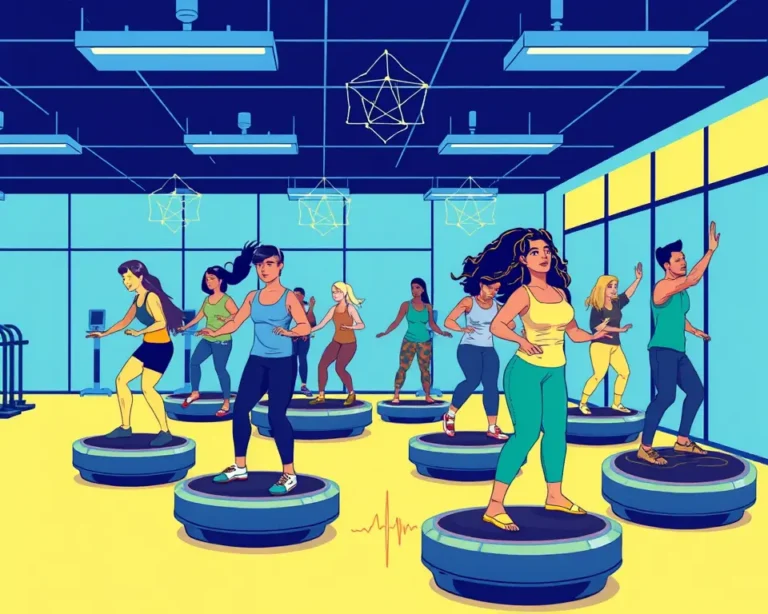Vibration plates, also known as power plates or vibration machines, are fitness devices that deliver whole-body vibration. They’ve gained popularity in gyms and homes as a way to potentially boost workout results. But how can you effectively incorporate a vibration plate into your gym routine? This comprehensive guide provides practical ways to integrate vibration plates, maximize their benefits, and ensure safe usage.
What is a Vibration Plate and How Does It Work?
A vibration plate is a platform that vibrates, typically at frequencies between 20 to 60 times per second. When you stand, sit, or perform exercises on the plate, these vibrations cause your muscles to rapidly contract and relax. This rapid muscle engagement is believed to offer several potential benefits, including:
- Increased Muscle Strength: The vibrations can lead to more muscle contractions per second compared to traditional workouts, potentially enhancing muscle activation.
- Improved Flexibility: Vibration training may improve mobility and flexibility when incorporated before or after workouts.
- Enhanced Circulation: Vibration plates can stimulate blood flow, potentially aiding in faster recovery and reducing muscle soreness.
- Potential Bone Density Improvement: Some studies suggest that vibration plate use may contribute to increased bone mineral density, particularly in postmenopausal women.
- Weight Loss Support: Vibration plates may assist in weight loss by increasing calorie burn and reducing visceral fat.
6 Ways to Integrate a Vibration Plate into Your Gym Routine
Here are six practical ways to incorporate a vibration plate into your gym routine:
1. Warm-Up Activation
- Purpose: Prepare muscles for exercise and improve blood flow.
- Exercises:
- Standing: Simply stand on the vibration plate with slightly bent knees for 1-3 minutes.
- Light Stretching: Perform gentle stretches like hamstring stretches, calf stretches, or torso twists while on the plate.
- Benefits: Enhanced muscle activation and increased circulation before more intense exercises.
2. Strength Training Enhancement
- Purpose: Increase the intensity of bodyweight exercises.
- Exercises:
- Squats: Perform squats with your feet hip-width apart on the vibration plate.
- Lunges: Step one foot onto the vibration plate and perform lunges, alternating legs.
- Push-Ups: Place your hands on the vibration plate and perform push-ups. You can modify by doing them on your knees.
- Plank: Hold a plank position with your forearms on the vibration plate.
- Benefits: The vibrations increase muscle engagement, potentially leading to greater strength gains and calorie burn. Studies suggest that 10 minutes on a power plate can be equivalent to 60 minutes of conventional workout.
3. Cool-Down and Recovery
- Purpose: Reduce muscle soreness and improve recovery after workouts.
- Exercises:
- Static Stretching: Perform static stretches (holding stretches for 30-60 seconds) on the vibration plate. Examples include hamstring stretch, quad stretch, and calf stretch.
- Seated Stretches: Sit on the vibration plate and perform stretches like seated figure-four stretch or cross-body stretch
- Benefits: Improved blood flow helps to repair muscle tissue and reduce post-exercise soreness.
4. Balance and Stability Training
- Purpose: Improve balance, coordination, and core strength.
- Exercises:
- Single-Leg Stand: Stand on one leg on the vibration plate, holding the position for 30-60 seconds.
- Balance Board Integration: If your gym has balance boards, try using them on the vibration plate for an added challenge.
- Benefits: The unstable surface challenges your neuromuscular system, enhancing balance and stability.
5. Targeted Cellulite Reduction Exercises
- Purpose: Reduce the appearance of cellulite in problem areas.
- Exercises:
- Squats, Calf Raises, and Lunges: These are the main exercises to target cellulite when using vibration plates
- Butt Exercises: Squats and lunges on the vibration plate can tighten muscles and skin, improving the shape of the buttocks.
- Benefits: Vibration helps break down fat cells, stimulate collagen production, and improve lymphatic drainage.
6. Lymphatic Drainage
- Purpose: Improve lymphatic flow
- Exercises:
- Standing: Stand on the vibration plate with feet shoulder-width apart.
- Heel and Toe Raises: Alternate between raising onto your toes and heels.
- Weight Shifts: Shift weight from right leg to left leg.
- Mini Squats: Perform mini squats with or without a resistance band.
- Shoulder Raises: Stand on the vibration plate and perform shoulder raises with or without dumbbells.
- Benefits: Gentle exercises help activate muscles and promote lymphatic flow throughout the body.
Sample Vibration Plate Workout Routine
Here is a sample routine that incorporates vibration plates into a full-body workout:
Warm-up (5 minutes)
- Standing on the vibration plate: 2 minutes
- Light stretching (hamstrings, calves, torso): 3 minutes
Workout (20 minutes)
- Squats: 3 sets of 15 reps
- Lunges: 3 sets of 12 reps per leg
- Push-ups: 3 sets to failure
- Plank: 3 sets, holding for 30-60 seconds
- Calf raises: 3 sets of 15 reps
Cool-down (5 minutes)
- Static stretching (quads, hip flexors, back): 5 minutes
Safety Precautions and Considerations
While vibration plates can offer several benefits, it’s essential to use them safely:
- Consult Your Doctor: If you have any pre-existing health conditions, such as heart conditions, are pregnant, or have medical implants, consult your doctor before using a vibration plate.
- Start Slowly: Begin with shorter sessions (10-15 minutes) and lower intensity levels, gradually increasing as your body adapts.
- Maintain Proper Form: Focus on maintaining good form during exercises to prevent injuries. If you’re unsure about proper form, consult with a personal trainer.
- Stay Hydrated: Drink plenty of water before, during, and after your workout.
- Listen to Your Body: If you experience pain, dizziness, or nausea, stop immediately.
- Avoid Overexertion: Limit use to 15-20 minutes per session, 3-4 days a week, to allow for adequate rest and recovery.
- Contraindications: Individuals with certain conditions should avoid vibration plates, including:
- Pregnancy
- Cardiovascular conditions
- Recent injuries or surgeries
- Epilepsy
- Metal implants
- Kidney or bladder stones
Potential Benefits of Vibration Plate Training
Research suggests that vibration plate training may offer a range of benefits:
- Increased Muscle Strength: Vibration plates can generate 30-50 muscle contractions per second, potentially leading to significant muscle activation.
- Enhanced Bone Mass: Vibration training may increase bone density, particularly beneficial for postmenopausal women.
- Improved Balance: The instability created by the vibration plate challenges your body to maintain balance, strengthening core muscles and improving stability.
- Cellulite Reduction: Vibration plate training can help reduce the appearance of cellulite by improving circulation, stimulating collagen production, and breaking down fat cells.
- Weight Loss: Vibration plates may aid weight loss by increasing calorie burn and reducing visceral fat. Studies have shown that vibration plates were better at reducing visceral fat than a traditional aerobic and resistance training program.
- Improved Lymphatic Drainage: Vibration plates can promote lymphatic drainage, helping to remove toxins and excess fluids from the body.
Potential Drawbacks and Side Effects
While generally safe, vibration plate training can have potential drawbacks and side effects if not used correctly:
- Vibration-Induced Discomfort: Some users may experience discomfort during or after their initial sessions. This is typically due to the rapid contraction and relaxation of muscle tissues.
- Joint Discomfort: Individuals with pre-existing joint conditions may experience discomfort due to the vibrations.
- Dizziness or Nausea: Some users may experience dizziness or nausea, especially during initial sessions, due to stimulation of the vestibular system (the body’s balance system).
- Aggravation of Existing Conditions: Vibration plates are not recommended for individuals with certain health conditions, as they may exacerbate the problem.
- Risk of Injury: Improper form or overuse can lead to muscle strains or other injuries.
Conclusion
Integrating a vibration plate into your gym routine can offer numerous potential benefits, from enhancing muscle strength and flexibility to improving balance and reducing cellulite. However, it’s crucial to use vibration plates safely and responsibly, consulting with your doctor, starting slowly, and maintaining proper form. By following these guidelines, you can effectively incorporate vibration plates into your fitness regimen and maximize their potential to help you achieve your fitness goals.







